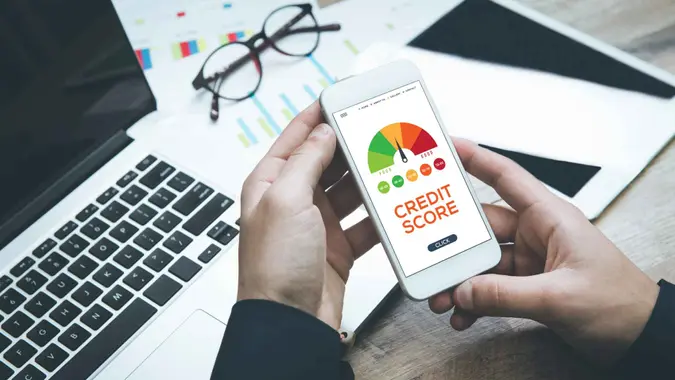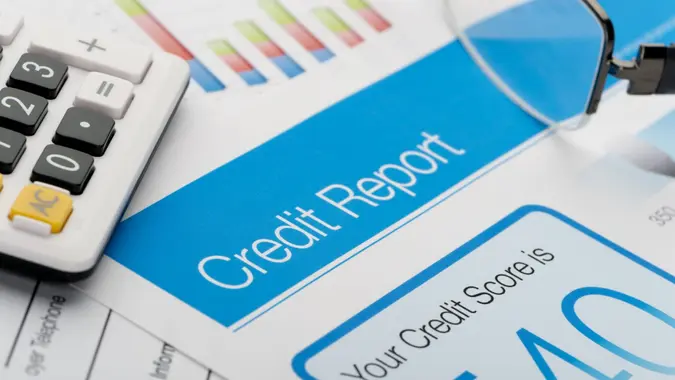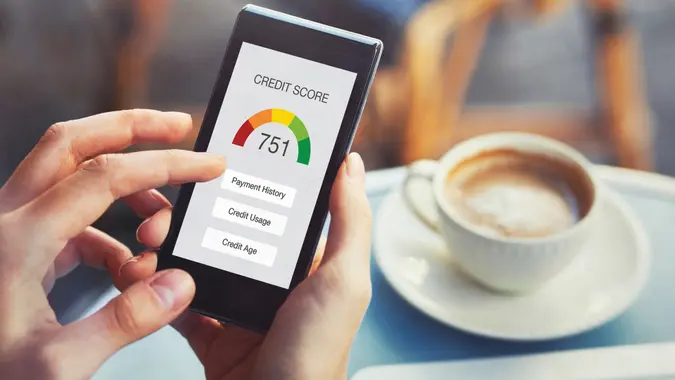I’m a Credit Expert: Avoid One Common Pitfall When Working To Improve Your Credit Score

Commitment to Our Readers
GOBankingRates' editorial team is committed to bringing you unbiased reviews and information. We use data-driven methodologies to evaluate financial products and services - our reviews and ratings are not influenced by advertisers. You can read more about our editorial guidelines and our products and services review methodology.

20 Years
Helping You Live Richer

Reviewed
by Experts

Trusted by
Millions of Readers
Credit scores are a key indicator of your financial worthiness in the eyes of lenders.
A healthy score can provide access to better interest rates for mortgages, auto loans, personal loans and more. Meanwhile, a low credit score can make it impossible to qualify for lines of credit and may hinder your ability to achieve milestones, like buying your first home or a new card. One factor in particular that can seriously damage your credit score is having too much debt.
According to the latest data from the Federal Reserve Bank of New York, American debt has reached staggering levels. Total U.S. household debt increased by $93 billion, reaching $18.04 billion as of Q4 2024. At the same time, credit card delinquency rates and mortgage balances are also up.
While these statistics are concerning, there are ways to improve your credit and get ahead. Credit expert John Ulzheimer spoke with CNBC Make It to explain the one mistake he made and how he fixed it.
Why It’s Important To Use More Than One Credit Card
Ulzheimer’s biggest credit mistake? He says it was only using one credit card with a low credit limit of just $600.
Since his credit limit was so low, he was usually maxing out the card and using too much of his available credit. To remedy this, he started opening additional credit cards to improve his credit utilization rate (which accounts for about 30% of your credit score).
It’s generally recommended by experts that you use less than 10% of your available credit at any given time. Maintaining multiple credit cards simultaneously may help lower your credit utilization ratio and improve your credit score.
How Your FICO Score Is Calculated
Another CNBC source with input from Ulzheimer explained that your FICO score, which is the primary credit score used by the majority of lenders, can range from 300 to 850 and is calculated based on several weighted categories:
- Your payment history (35%): Calculated by whether you’ve paid your credit card bills in full and on time.
- The amounts you owe (30%): Calculated by the amount of credit you’re using and how high of balance you’re carrying.
- The length of your credit history (15%): Determined by how long you’ve had credit cards, how long you’ve been paying back loans, etc.
- Your credit mix (10%): Determined by the blend of credit accounts you’re maintaining, from credit cards to installment loans and more.
- New lines of credit (10%): Determined by the length of time since you’ve applied for new lines of credit.
Considerations Before Opening Multiple Credit Cards
If you’re looking to increase your credit limit, opening multiple cards is one way to do that. However, it’s not for everyone since a higher credit limit means the ability to overspend, which may potentially land you in debt.
“Some people think a $10,000 credit limit means that you somehow have $10,000 cash, and then it’s OK to go out and spend all this stuff,” said Ulzheimer.
He furthered that discipline and self-control are key. Just because you may have multiple credit cards simultaneously and a high combined credit limit, this doesn’t mean you should spend more money than you can afford to pay.
“It does take discipline to not go crazy and go out and spend, spend, spend, just because you have the capability of doing so,” explained Ulzheimer.
If you’re too tempted, it’s not a bad idea to stick to debit cards to avoid accumulating credit card debt.
 Written by
Written by  Edited by
Edited by 






















